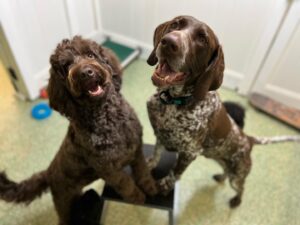 As the seasons shift, so do the needs of your dog’s coat. Whether you’re bundling up for winter or preparing for the summer heat, understanding the nuances of your dog’s coat can help you provide the best care possible, ensuring they remain comfortable and healthy year-round.
As the seasons shift, so do the needs of your dog’s coat. Whether you’re bundling up for winter or preparing for the summer heat, understanding the nuances of your dog’s coat can help you provide the best care possible, ensuring they remain comfortable and healthy year-round.
Seasonal Shedding: What to Expect
- Spring and Fall Shedding: Most dog breeds undergo significant shedding during the spring and fall. In spring, dogs shed their thick winter undercoats to prepare for warmer weather. Conversely, in autumn, dogs begin to develop a denser coat in anticipation of colder months. This process can vary greatly depending on the breed and the climate in which the dog lives.
- Summer and Winter Considerations: While shedding might be less intense in summer and winter, these seasons are not without their challenges. In summer, ensure your dog’s coat remains free of mats and tangles, which can trap heat and cause overheating. In winter, longer coats might require more frequent grooming to prevent the accumulation of wet debris and ice, particularly in the paws and underbelly areas.
Grooming Tips for Each Season
Spring:
- Intensive Brushing: Increase brushing frequency to help remove the winter undercoat. Tools like undercoat rakes or deshedding tools can be especially effective.
- Bathing: Bathing can help loosen dead fur but be sure to thoroughly dry your dog to prevent chill, especially in unpredictable spring weather.
Summer:
- Hydration and Protection: While trimming or shaving might seem like a good idea for keeping your dog cool, it’s essential to consult with a professional groomer or vet first. Some coats protect dogs from the sun, and removing them can lead to sunburns.
- Frequent Brushing: Continue to brush regularly to prevent mats, which can harbor bacteria or parasites.
Fall:
- Preparation for Cold: As your dog’s coat grows thicker, regular grooming is crucial to distribute natural skin oils and prevent mats, which can hold damp and cold against the skin in winter.
- Paw Care: Start paying more attention to paw care, ensuring that nails are trimmed and pads are not cracked, as dogs prepare for more indoor time.
Winter:
- Dry Skin Care: The dry winter air can cause flaky skin. Consider incorporating a supplement with omega fatty acids into your dog’s diet to promote healthy skin and fur.
- Gentle Drying: After baths, make sure your dog is completely dry before going outside. Use a blow dryer on a low, warm setting if necessary.
Long-haired vs. Short-haired Breeds
 Grooming techniques may differ significantly between long-haired and short-haired breeds. Long-haired dogs often require daily brushing to prevent severe matting and tangling, while short-haired breeds might do well with less frequent grooming. Regardless of hair type, check regularly for signs of skin issues, ticks, or fleas, which can hide beneath the coat.
Grooming techniques may differ significantly between long-haired and short-haired breeds. Long-haired dogs often require daily brushing to prevent severe matting and tangling, while short-haired breeds might do well with less frequent grooming. Regardless of hair type, check regularly for signs of skin issues, ticks, or fleas, which can hide beneath the coat.
Professional Grooming
 While regular home grooming is essential, professional groomers can provide deep cleaning, thorough brushing, and even seasonal haircuts that might be challenging to do at home. They can also offer advice tailored to your dog’s specific coat type and lifestyle needs.
While regular home grooming is essential, professional groomers can provide deep cleaning, thorough brushing, and even seasonal haircuts that might be challenging to do at home. They can also offer advice tailored to your dog’s specific coat type and lifestyle needs.
Maintaining your dog’s coat isn’t just about keeping them looking good—it’s a crucial part of their health and comfort. As the seasons change, adjust your grooming routine to match the environmental demands, ensuring your furry friend is as happy and healthy as possible, no matter the weather.